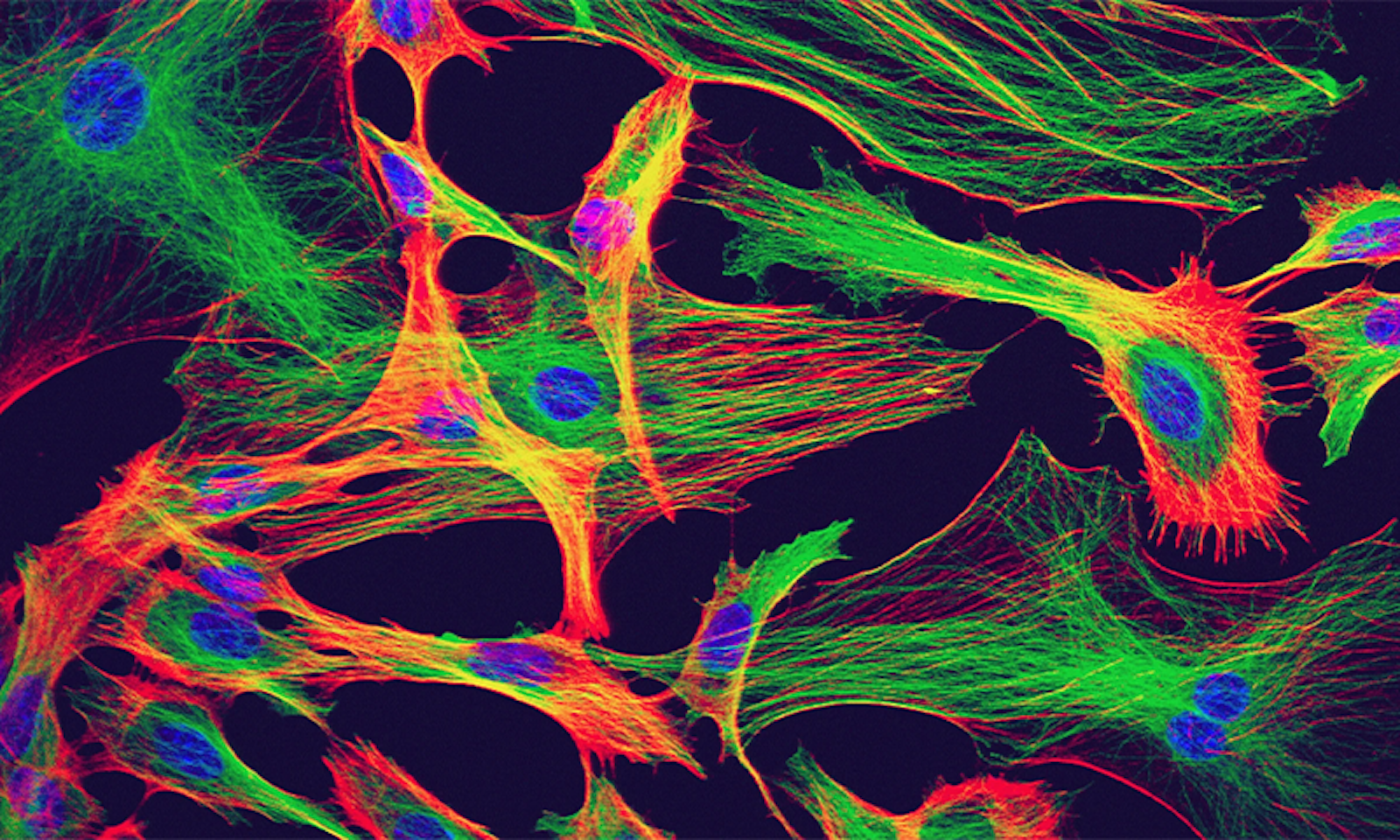A brain is nothing if not communicative. Neurons are the chatterboxes of this conversational organ, and they speak with one another by exchanging pulses of electricity using chemical messengers called neurotransmitters. By repeating this process billions of times per second, a brain converts clusters of chemicals into coordinated actions, memories, and thoughts.
Researchers study how the brain works by eavesdropping on that chemical conversation. But neurons talk so loudly and often that if there are other, quieter voices, it might be hard to hear them.
For most of the 20th century, neuroscientists largely agreed that neurons are the only brain cells that propagate electrical signals. All the other brain cells, called glia, were thought to serve purely supportive roles. Then, in 1990, a curious phenomenon emerged: Researchers observed an astrocyte, a subtype of glial cell, responding to glutamate, the main neurotransmitter that generates electrical activity.
In the decades since, research teams have come up with conflicting evidence, some reporting that astrocytes signal, and others retorting that they definitely do not. The disagreement played out at conferences and in review after review of the evidence. The two sides seemed irreconcilable.
A paper published in Nature in September presents the best proof yet that astrocytes can signal, gathered over eight years by a team co-led by Andrea Volterra, visiting faculty at the Wyss Center for Bio and Neuro Engineering in Geneva, Switzerland. The study includes two key pieces of evidence: images of glutamate flowing from astrocytes, and genetic data suggesting that these cells, dubbed glutamatergic astrocytes, have the cellular machinery to use glutamate the way neurons do.
The paper also helps explain the decades of contradictory findings. Because only some astrocytes can perform this signaling, both sides of the controversy are, in a sense, right: A researcher’s results depend on which astrocytes they sampled.
“This study is so cool because it provides an explanation for why both of those pieces of data were out there and conflicting,” said Christopher Dulla, a professor of neuroscience at Tufts University who studies astrocytic signaling and was not involved in the new work. “I tend to buy it.”
The discovery opens the possibility that some astrocytes form an essential part of the brain’s circuitry. “More and more we come to the idea that there is a participation of all the cell types to the function of the brain,” Volterra said. “It’s much more integrated than it was thought before.”
A Communicative Web
The catch-all name “glia”—from the Greek word for “glue”—for all brain cells that aren’t neurons, like astrocytes, conveys scientists’ initial view that their main purpose was to hold neurons together. However, since the first description of astrocytes in 1865, researchers have discovered that they can do much more. For one thing, they have glutamate receptors, which they use to detect and clean up excess neurotransmitters in the spaces around neurons.
What’s been less clear is whether they can use glutamate to generate an electrical signal on their own. In 1994, researchers stimulated astrocytes in a dish and saw nearby neurons appear to respond by preparing to send a signal. And in 1997, Volterra and his colleagues observed the reverse: Rat astrocytes answered neurons’ calls with oscillating waves of the signaling molecule calcium. From 2000 to 2012, researchers published more than 100 papers reporting evidence in favor of astrocytes’ ability to communicate via synapses.
But others questioned how that evidence was gathered and interpreted. In 2014, for example, researchers discovered that a key mouse model was flawed, raising questions about the prior studies that used those mice.

Meanwhile, the view of astrocytes was evolving, and scientists were beginning to consider them active participants in the brain’s processing of information. While neurons and their branching dendrites are often pictured as trees, astrocytes are more like a fungus, forming a tightly woven mat that blankets the brain and shares information among its constituent parts. In this way, astrocytes seem to form a coordinated web that influences neuronal activity. For example, in 2016, while conducting neuroscience research at the University of California, San Francisco, Kira Poskanzer discovered that mouse astrocytes can prompt nearby neurons to enter a rhythmic sleep state by regulating glutamate.
“It’s less like an individual cell doing its own thing and more like part of a whole team of cells working together,” said Poskanzer, now at the biotech startup Arcadia Science.
However, there’s a difference between mopping up glutamate and truly generating signals. Volterra believed that some astrocytes were capable of the latter. But to prove it, he needed evidence that astrocytes can send signals and have the right tools to do so in relevant, meaningful ways.
A New Class of Brain Cell
Volterra took advantage of a new approach to studying the brain: single-cell RNA sequencing, which takes a snapshot of the complete suite of genes active in individual cells throughout a tissue. Combing through eight databases of mouse hippocampal cells, he identified nine clusters of astrocytes, distinguished by their gene activity. Astrocytes in one—and only one—of the clusters transcribed proteins known to be involved in neurotransmitter storage, release, and transport using vesicles, as occurs in neurons. The cells were not evenly distributed across the brain region, or even throughout specific circuits.
To see whether people have these cells, Volterra and his team searched three databases of human hippocampal cells for the same protein signatures they had seen in the mouse astrocytes. The signatures appeared in all three data sets.
That genetic data, though, was still indirect evidence. Volterra needed to show the signaling in action. He and his team simulated a neuronal signal to astrocytes in slices of mouse brain and took images of the molecules released by the astrocytes. Some—but not all—astrocytes responded with glutamate. And when the researchers prevented astrocytes from using vesicles, the cells could no longer release glutamate.
To Volterra, the evidence was clear. “We were right. There are astrocytes that release glutamate,” he said. “But we were also wrong, because we thought all astrocytes release glutamate.”
The findings almost certainly upend the current understanding of the way the brain communicates, said Dmitri Rusakov, a professor of neuroscience at University College London who was not involved in the work. But in what way is an open question.
Knowing that astrocytes can signal is only the first step. That fact doesn’t answer how synapses respond to astrocytic glutamate. It doesn’t say which functions require astrocyte signaling instead of, or in addition to, neurons. It doesn’t account for why some areas of the brain have more glutamatergic astrocytes than others, or why a subset uses this function while the rest do not.
Instead, like all new discoveries, it poses new questions for science to answer.
“We’ve got a significant body of evidence,” Rusakov said. “Now you need a theory to put it all together.”
This article was originally published on the Quanta Abstractions blog.
Lead image: New evidence suggests that some astrocytes can stimulate electrical signals just as neurons do. Credit: David Robertson, ICR / Science Source




























